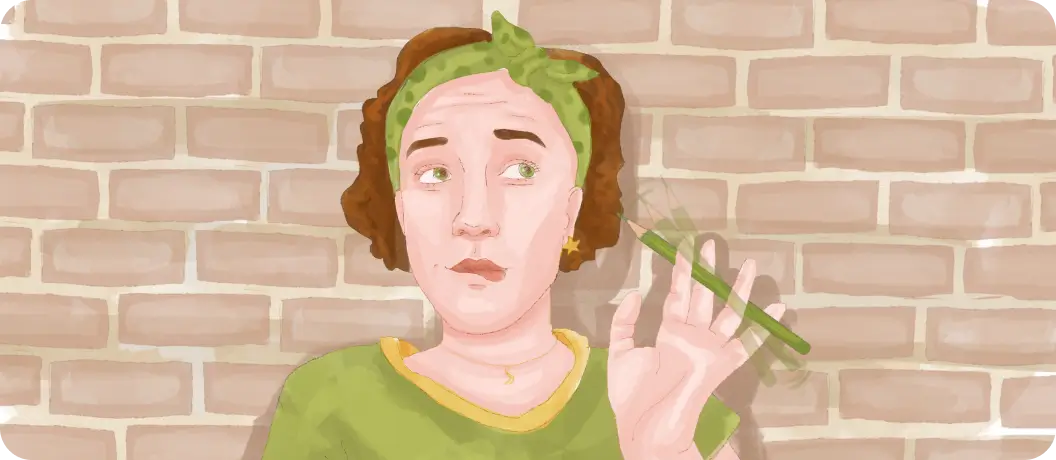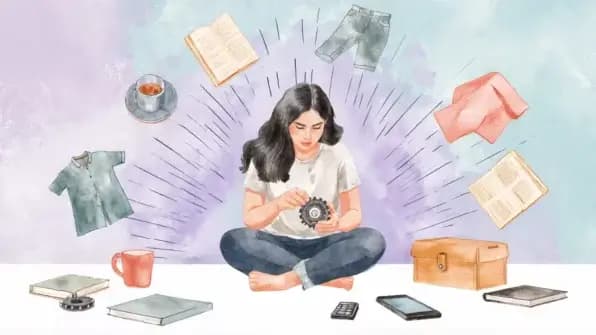Do you constantly chew pens, shake legs, and play with scrunchies? If yes, this article is for you.
While many believe everyone does something similar, this might be a first warning sign. Sure, many people fidget a bit, but did you know such habits might be your brain’s way of coping with intense emotions?
These little quirks, often called stimming, are super common in people with certain mental health conditions.
Below, we’ll dive into what stimming attention-deficit/hyperactivity disorder (ADHD) is all about, what triggers it, and how it ties into mental health issues. Let’s get to the bottom of this behavior and see what it might be trying to tell you about your well-being.
What does stimming mean?
Stimming is a self-stimulatory behavior that usually includes repetitive movements and sounds. You may do this consciously or unconsciously to calm anxious thoughts, regulate emotions, concentrate, and cope with overwhelming sensory input.
Whether it’s tapping your foot, clicking a pen, or humming a tune, these actions can help you stay grounded and focused in your daily life.
Is stimming normal?
Yes, it is. Stimming shouldn’t necessarily be associated with any mental health condition and can be harmless and healthy behavior.
Nonetheless, stimming may become excessive, highlighting an underlying issue that might need attention. If self-stimulating behavior starts interfering with daily life, it can be a sign to seek professional advice.
Fidgeting vs. stimming
Why do people bounce their legs? As a rule, it can be a sign of fidgeting or stimming. But what’s the difference?
At first glance, these two behaviors might seem similar, but they serve different purposes and often stem from different needs.
Fidgeting is usually a way to release excess energy and stay focused. Many neurotypical people fidget when bored, anxious, or trying to concentrate on a task. This behavior is generally mild and often provides enough movement to keep the mind engaged.
Stimming is usually much more severe and noticeable. It can involve rubbing feet together, hand-clapping, or talking to oneself. While the manifestations can be different, the underlying reason is usually the same: people try to cope with feelings of being overwhelmed or stressed.
Unlike fidgeting, stimming results from the need for sensory and emotional regulation. If it becomes too frequent or intense, it can decrease the quality of life.
Do people with ADHD stim?
Remember Dory from the animated film “Finding Nemo” and its sequel “Finding Dory”? She’s a forgetful and energetic fish who exhibits ADHD-like behavior.
Dory frequently engages in stimming, such as singing to herself, repeating phrases, and swimming in circles. These actions help her manage emotions her anxiety and cope with her short-term memory loss. Stimming is her way to maintain calm when experiencing the overstimulation associated with ADHD.
The reality is quite similar. Self-stimulatory behavior is a visible part of the ADHD iceberg that many people experience.
What is ADHD stimming?
People with ADHD engage in self-stimulation to manage restlessness, maintain focus, or cope with boredom.
Does ADHD cause stimming? Actually, it can.
ADHD affects the way our brain works. As a result, people living with this mental health condition may have difficulties with concentration, dealing with boredom, or managing emotions.
To self-soothe, channel their energy, and control impulses, they can engage in self-stimulatory behavior. Moreover, for some adults and especially kids with ADHD, stimming’s meaning is to improve mood and lower stress levels.
What about people with AuDHD?
Interestingly, there’s a noticeable percentage of people living with both ADHD and autism spectrum disorder (ASD). This phenomenon is called AuDHD, an unofficial term for the overlap between two mental health conditions.
For people with AuDHD, stimming can be wildly diverse and complex. They might engage in behaviors like fidgeting with fingers, humming, or even organizing and reorganizing things. This blend of behaviors often serves multiple purposes, helping them navigate their unique sensory experiences.
Triggers of ADHD stimming
“Stimming is like turning down the radio when you think you smell something burning. It’s the way of turning off the other senses so you can make sure nothing is burning.” — Omari Latif Hardwick, American actor.
So, why do I rock back and forth? Many triggers can cause you to engage in stimming behaviors. Below, we’ll delve into the most common ones.
- Frustration. Have you had a classmate who used to chew a pen during tedious lessons? While they might not necessarily be neurodivergent, such stimming behavior is common for people with ADHD to cope with boredom.
- Stress. Well, most people will probably understand this feeling. You’re sitting in a doctor’s office waiting for the results of your tests or looking at your laptop and expecting an answer from HR about your dream job offer. Many of us may start tapping our fingers, fidgeting with a pen, or twirling our hair to manage nervousness.
- Overstimulation & mental exhaustion. Imagine being in a concert with loud noises and bright lights. This sensory overload can quickly lead to mental exhaustion. For those who might experience ADHD overstimulation, stims can provide a much-needed break and ground the mind, offering a momentary escape from the chaos.
- Lack of focus & restlessness. People with ADHD often face the question, “Why can’t I focus?” They might need a physical outlet for excess energy to improve concentration, making it easier to concentrate and stay engaged with tasks.
- Excitement. Emotional dysregulation & ADHD are strongly connected. When people with attention-deficit/hyperactivity disorder experience overwhelming positive emotions, they might start singing or scratching just to calm down.
ADHD stimming examples
So, now you can analyze your behavior and find out what makes you engage in self-stimulatory behavior. But did you know that there are various types of stimming?
Let’s learn the main categories, talk about their differences, and discuss ways to manage them.
Vocal stimming
Some also call it “verbal stimming.” It can include behaviors like humming, repeating words or phrases, making noises, or talking to oneself.
Think about your colleague sitting beside you in the office and constantly clearing his throat. It may also be a kind of stimming.
Why do people with ADHD do this? The repetitiveness of vocal sounds can give a sense of predictability, which is especially beneficial during stressful situations. Additionally, it creates a calming environment.
Take into account that verbal stimming can become disruptive. To reduce the need for repeating sounds, you may try mindful techniques or the 333 rule for anxiety.
Visual stimming
You’ve definitely seen someone “zoning out” during a conversation. You can joke that such people reboot this way like robots, as, in fact, it is really pretty similar.
What is visual stimming in ADHD? It may be staring at a spinning fan, observing reflections in a mirror, or watching colorful lights blink.
Visual ADHD stimming can also offer a mental break from overwhelming environments by focusing on visually calming stimuli.
If you find visual stimming uncontrollable, you may try to create an environment with calming patterns and take visual breaks.

Tactile stimming
This is probably the most common type. Tactile ADHD stimming in adults can involve dozens of variations, from rubbing and scratching to feeling different fabrics.
Usually, people do this to feel calming physical sensations, which help them stay focused by providing sensory feedback through touch.
How can you manage tactical stimming? There’s nothing wrong with this behavior until it starts interrupting your life (as well as with all other types of stimming). You can use small objects to fidget or wear textured clothes to make this sensory break unnoticeable.
Balance-based stimming
Rocking back and forth, swinging on a swing set, or spinning in place stimulates the vestibular system.
Let’s look at Bart Simpson from “The Simpsons.” Even though the creators have not confirmed that he has ADHD, he does show some signs of it.
Bart can be a perfect example of a character who engages in balance-based stimming. He often has restless energy, and to calm down, he bounces on his skateboard, spins around, or constantly moves.
If you experience something similar, trying activities that provide a controlled vestibular input, like using a rocking chair, practicing yoga, or engaging in balance exercises, may be helpful.
ADHD stimming VS. autism stimming
Do ADHD people stim? As you already understand, yes. However, many people associate stimming with ASD. What’s the difference between these two phenomena?
It’s essential to note that stimming is the diagnostic criteria for ASD. The main purpose of people with autism is to relieve anxiety from external stimuli.
Their behavior may serve as a way to block out overwhelming sensory input or to create a sense of predictability in an unpredictable world. This can include repetitive body movements or repeating certain sounds.
Note that ADHD and autism impact distinct areas of the brain. While the behaviors might look similar, the underlying reasons are different: for those with ADHD, stimming helps channel their boundless energy and calm their minds.
FAQ about ADHD and stimming
Why do I stim?
Shortly, it is a tough question to answer. You already know that there are many triggers of ADHD stimming.
What’s more, it’s important to remember that neurotypical people can stim from time to time as well.
To understand what emotions make you engage in such behaviors, you can track your mood with Breeze. If it isn’t enough and you feel that stimming starts interfering with your daily activities, contacting a healthcare professional may be rather helpful.
How to manage stimming?
If stimming makes your life worse and you want to make its manifestations less severe and frequent, several strategies might be helpful:
- breaking huge tasks into smaller pieces and taking breaks regularly
- working in less stimulating, well-organized environments
- doing breathing exercises to calm down when feeling nervous
- engaging in physical activities regularly
- playing games that help improve concentration
- working on other symptoms of ADHD if you experience them as well
My partner stims too much. How can I help?
ADHD stimming in adults might be especially difficult to handle if your loved one does it regularly.
The first thing you need to remember is not to judge your partner. Remember that stimming is a self-soothing behavior that allows people to handle life challenges.
Encourage your loved one to engage in other activities when you see the first signs of stimming. Try to spend more time with them when doing complex tasks. The presence of another person often helps calm down and feel much better.
It’s vital to be kind both to yourself and the people around you if they do something self-stimulatory. Moreover, if you suppose that stimming comes from ADHD symptoms, you can support your loved one by helping them seek professional advice. Providing an understanding environment can significantly affect how people cope with stimming.
Disclaimer
This article is for general informative and self-discovery purposes only. It should not replace expert guidance from professionals.
Any action you take in response to the information in this article, whether directly or indirectly, is solely your responsibility and is done at your own risk. Breeze content team and its mental health experts disclaim any liability, loss, or risk, personal, professional, or otherwise, which may result from the use and/or application of any content.
Always consult your doctor or other certified health practitioner with any medical questions or concerns
Breeze articles exclusively cite trusted sources, such as academic research institutions and medical associations, including research and studies from PubMed, ResearchGate, or similar databases. Examine our subject-matter editors and editorial process to see how we verify facts and maintain the accuracy, reliability, and trustworthiness of our material.
Was this article helpful?






